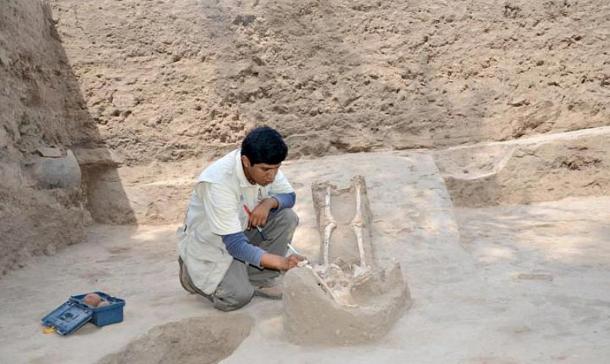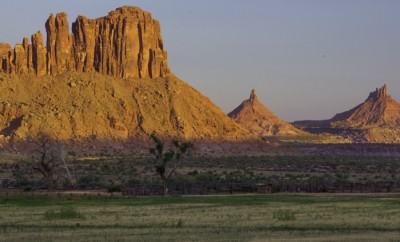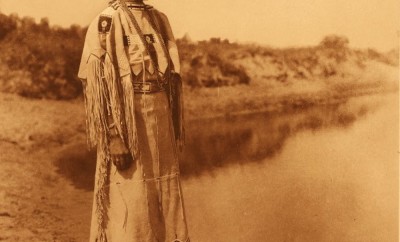Cultures
Secret Sacrificial Chamber Discovered In Peru

Image: Ancient Origins
Secret Sacrificial Chamber Discovered In Peru
Archaeologists uncovered evidence of a grisly past this January when they found the ruins of an ancient sacrificial chamber buried near the Pucalá district of Peru where sacrificial rituals were apparently performed roughly 1,200 years ago.
Within the ruins, the remains of six women and a llama were found, in addition to a partially preserved collection of ceramics. The state of the women’s remains suggests that they were sacrificed within the ceremonial temple, as all of their skulls were positioned to face the Andes mountain range and several of their bodies were mangled into unnatural configurations.
According to the Daily Mail, experts say the women were likely killed during rituals wherein people wore ceremonial dress and possibly drank the blood of the victims. The realities of these rituals is still subject to much speculation, as this Peruvian temple is one of the first of its kind to be unearthed.
“We have discovered a temple around 1,200-years-old and which was a secret enclosure that priests used to sacrifice women to their gods,” said Edgar Bracamonte, the lead archaeologist on the dig. “It was used for private ceremonies. It has platforms and a central ramp that was covered with earth, where they left a large quantity of offerings. We found six buried women in different places.”
Peru was famously home to the Incas society, but this temple predates the spread of their civilization by a few hundred years. The recently uncovered temple is likely the product of the Lambayeque, or Sican, culture that flourished along the north coast of Peru roughly from 750 AD to 1375 AD.
The Lambayeque constructed large cities centered around worship and enormous temples. They made no apparent attempts to acquire additional land or rule other peoples, and were defeated by the expanding Chimu empire. That was likely 25 years before the Incans rose to prominence from 1400 AD to 1533 AD.
Their culture rose to prominence after the region’s Moche culture, though there may have been some overlap between the two societies, and are believed to have traded with other peoples throughout the South American continent from present-day Ecuador, Chile and Colombia.
The artifacts discovered at the temple indicate that the Lambayeque and other pre-Incan peoples in the region had cultural ties. The ruins contained ceramics and other artifacts that appear to be from the Moche, Wari and Cajamarca civilizations, suggesting a close relationship between the disparate cultures.
All three cultures existed in the area for hundreds of years, overlapping slightly with the existence of the Lambayeque. The Wari civilization is believed to have lasted from 500 AD to 900 AD, while the Moche civilization existed in northern Peru from 100 AD to 800 AD and the Cajamarca from 200 AD to 800 AD.
Archaeologists uncovered the temple at the Huaca Santa Rosa, 18 miles from the city of Chiclayo near Peru’s northern Pacific coast. Though there’s little argument about the use of this temple for human sacrifice, certain elements of the structure raise new questions for researchers, as the sacrificed women’s remains are oriented in a different manner as the sacrificed men found at other Lambayeque sites.
Bracamonte explained, “What caught our attention was the unusual position of a young woman of around 24-years-old. She was positioned in the centre of the ramp together with a llama and ceramic pots.”
It’s unclear if the women were Lambayeque or from another culture, or how they came to be sacrificed at the site, though one theory states that they were captured and taken as slaves. It is possible the sacrificial rituals of the Lambayeque inspired the similar ceremonial tendencies of the Incas that came after them.
Other ruins have been discovered throughout Peru of chambers of the Incas used to sacrifice children to their gods, as recently as October of 2015 when explorers found a religious complex in the remote Vilcabamba mountain range nearly 100 miles north of Cusco.
Beneath the ruins of the sacrificial chamber ran a complex system of caves used to bury the bodies of the sacrificed victims, likely dating back to the time of the Incan leader Túpaq Inca Yupanqui who served from 1471 to 1493. During his time as ruler, child sacrifices were committed during times of drought and disaster so the gods might bring them good fortune in return.
Though the correlation between the Incas and Lambayeque is still unproven, this new discovery of the temple points to a regional history wherein the separate cultures were tied more closely than previously thought.





0 comments